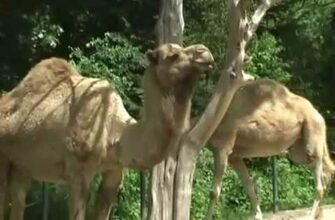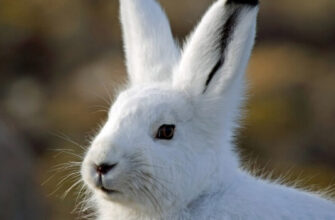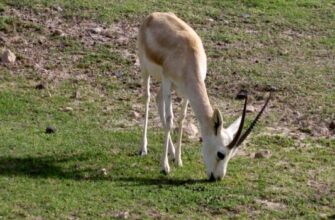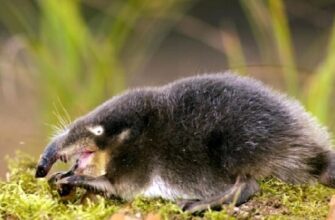Boar (aka boar, aka billhook, or wild pig) is a widespread animal belonging to the family of mammals. Outwardly, the wild boar looks almost the same as an ordinary domestic pig, only wears a bristly and warm “fur coat”. This is not surprising, since it is its direct ancestor.
Species origin and description
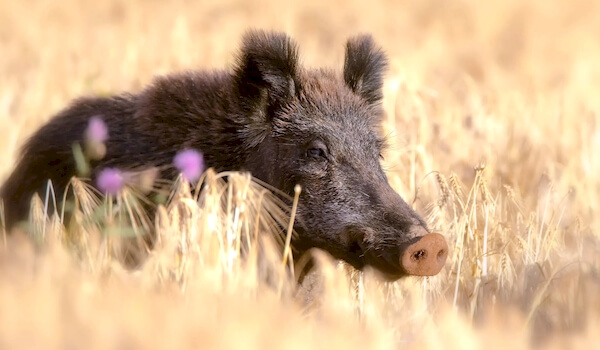
Photo: Boar
A wild boar is a mammal belonging to the order of artiodactyls, the suborder of pig-like (not ruminant) and the genus of wild boars. Zoologists, based on the facts of finding the remains of bones, consider the boar to be a very ancient animal, dating back to the pre-glacial era. Over many centuries of existence, the wild boar has undergone many disasters, climate changes, extinction of certain species of animals and plants, severe ice ages, various cataclysms and transformations that occur with the globe as a whole. Although many species of living creatures disappeared from the face of the earth in that distant and cruel period, the wild boar was able to adapt and survive.
Video: Boar
This species of animals turned out to be quite stable, unpretentious in the choice of food, adapted to extreme cold and other natural trials. Of all the families of the order of artiodactyls, which were ubiquitous in the pre-glacial period, only one has survived to this day, it is called “real pigs”.
It includes five genera:
- babirousse (lives on Celebes island);
- warthogs (Africa);
- long-haired pigs (tropics of Africa and Madagascar);
- wild boars (northern Africa, Europe, Asia).
Only three species of wild pigs can be attributed to the genus of wild boars:
- common boar (northern Africa, Asia, Europe);
- bearded pig (Java, Sumatra, Celebes, Malun and Philippine islands);
- pygmy pig (Himalayas).
It is worth noting that, despite the difficult, sometimes hopeless conditions of existence in antiquity, the boar did not change its appearance, given to it by nature back in those days. This is evidenced by the findings of the remains of bones, which can be used to recreate the appearance of the animal. He managed to adapt to the appearance of man and all the changes in the outside world associated with this event, although many larger animals could not stand it.
Appearance and features
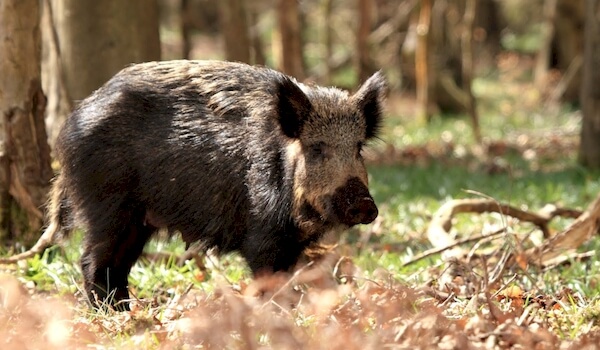
Photo : Animal boar
The appearance of a wild boar differs from an ordinary domestic pig in many ways, this is due to the more severe living conditions. The boar looks very powerful and strong, its physique is quite dense. The body is shortened with a small tail, the legs are not long, the chest is wide, powerful, and the pelvis is narrow. The neck is large, thick and short, and the head is wedge-shaped. The nose, like that of a familiar domestic pig, is in the form of a patch. The ears are pointed and erect.
The wool of the boar is coarse, hard, bristly. It comes in different colors, depending on the habitat of the animal. Usually from dark gray to brown, brown. In winter, it becomes much thicker, a warm undercoat grows.
The size of the boar’s body reaches two meters in length. The height of the animal is about a meter. The average weight varies from 150 to 200 kg. There are individuals weighing about three centners, and there are also very small ones – 50 kg. The male is much larger than the female.
One of the attractions of the boar’s appearance is its huge fangs. In adults, they have a length of 20 – 25 cm. Fangs, like powerful excavators, interrupt the ground cover in search of food and serve as a defense tool against ill-wishers. The appearance of wild boars differs in many ways, depending on their place of permanent residence.
Only in Russia there are five different subspecies of wild boars:
- Central European wild boar ( in the west and in the center of the country), the skin of this species is dark, the size is small;
- the Romanian or Caucasian wild boar (Caucasus, Transcaucasia), is larger than the Central European. It has a large head, lighter hair;
- Central Asian wild boar (border with Kazakhstan), a large animal, the coat color is light, and the legs are dark;
- Transbaikal wild boar (Transbaikalia, Baikal region), color very dark, brown, small in size;
- Ussuri boar (Amur region, Primorsky Territory), the animal has a large body and head, the color is almost black, it has a white mustache and short ears pressed against the head.
Wherever the wild boar lives, no matter how the wild boar looks, one thing remains unchanged – this is its snout, which is a symbol of its belonging to the suborder of pigs.
Where does the wild boar live?
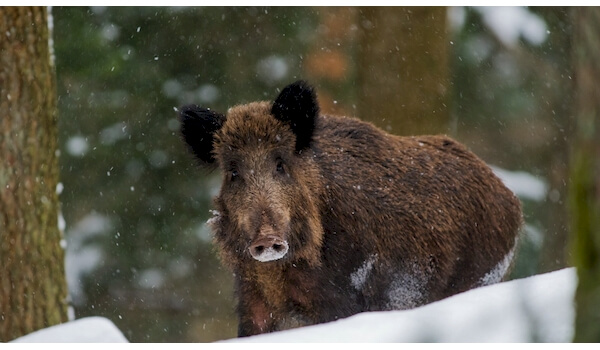
Photo: Wild boar in winter
Among mammals leading a terrestrial lifestyle, wild boars are the most widespread. This animal can perfectly settle down in hot countries with a tropical climate, as well as in countries with harsh, cold climatic conditions. It lives both in broad-leaved, mixed forests, and in coniferous. In our country, the wild boar loves, first of all, oak massifs. The boar lives perfectly at various altitude levels in the mountains, and does not disdain alpine meadows. The wild boar loves not only oak forests, but also beech forests, as well as swampy areas.
They are distributed almost all over the globe: from the Atlantic Ocean to the Ural mountains, in the Mediterranean, including in northern Africa, in the steppes of Central Asia and Eurasia. As for the northern regions, the wild boar’s habitat there reaches 50 degrees north latitude, in the east – to the Amur and the Himalayas. The family of wild boars lives in China, and in Korea, and in Japan, and in the countries of Southeast Asia. In addition to the mainland, the wild boar lives on many islands.
In the modern world, wild boars inhabit a much smaller area than it was in antiquity. In many countries (England) it was completely exterminated. In our country, the wild boar population is not threatened by anything, its range is quite large: the European part of the country, the mountains, the south of Siberia, the Caucasus. An interesting fact is that wild boars did not exist in North America at all until a person brought them there for the purpose of hunting. Then they settled remarkably and settled throughout the mainland. Scientists believe that the real ancestors of the common domestic pig are wild boars, which were common in Mesopotamia and Europe.
What does a wild boar eat?
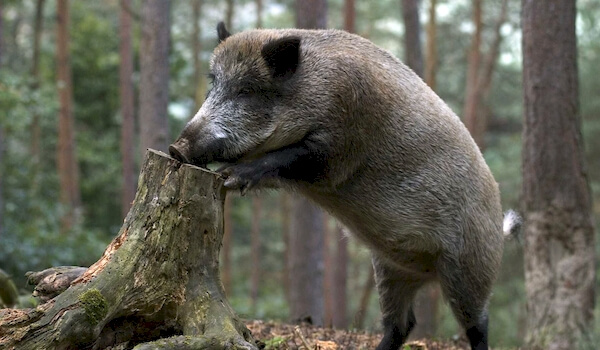
Photo: Wild boar in the forest
Boars have a rather serious, slightly intimidating, imposing appearance, and many believe that they are very predatory. These stocky animals are omnivores by nature. A large part of their diet is plant foods. Depending on the change of seasons, the diet of wild boars also changes. With the help of their most powerful fangs, boars love to dig out various tubers of bulbous plants, succulent roots, various bugs, larvae, and worms from under the ground. In spring and summer, the wild boar is not averse to feasting on fresh foliage, young shoots, berries, and other fruits.
The wild boar loves acorns and nuts. If there are sown fields nearby, then he can eat cereals (wheat and oats), vegetables and other agricultural plants. The boar loves frogs, small rodents, and does not disdain carrion. He steals eggs from bird nests, which he also loves very much.
It is interesting that a mature animal eats from 3 to 6 kilograms of various foods in one day, it all depends on its type and size. Water is also of great importance in the diet of the wild boar, they drink a fairly large amount of it every day. In search of a drink, wild boars come to rivers and lakes. Thanks to this, they can catch and eat fresh fish, which is a delicacy for them. It has been noticed that a wild boar digs up 50 percent of its food from the ground, because it contains enough variety of delicacies to feed and keep such a large animal active.
Peculiarities of character and lifestyle
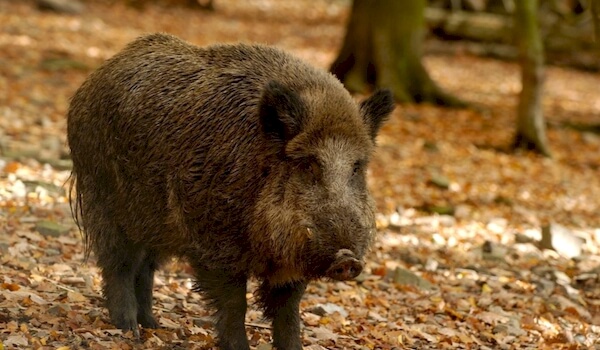
Photo: Boar in Russia
For wild boars, the environment of swamps and water-rich areas with reeds and shrubs is most favorable. The sight of the boar often fails, which cannot be said about the sense of smell, which is simply excellent. The boar scent is able to smell a person within a radius of four hundred meters. Smells that are too sharp and unusual for the animal’s habitat can scare away the beast.
Wild boars live in herds. As a rule, they contain several females with cubs, very young males. Mature boars are kept by the side, alone. They come to herds only during the mating season. The wild boar is most mobile and active at night. At night, he likes to eat and swim (even in the mud). During the day, wild boars cool off in the reed thicket or in the swamp, hiding in the bushes.
Interestingly, the skin of wild boars is very susceptible to sunlight, so they cover it with a layer of dirt so as not to burn. They use mud not only as a sunblock, but also as a reliable protection against the bites of annoying insects. Near the rookery of a wild boar there should always be some kind of reservoir. The boar tries to stay as far away from human settlements as possible, but he visits the oat, wheat and corn crops regularly and with great pleasure.
Both in summer and in winter, the billhook prefers to lead a measured sedentary lifestyle, leaving their shelters only to eat. But in various situations, the boar can develop its speed up to 45 kilometers per hour. In addition, he swims great, overcoming huge distances. To the excellent sense of smell, you can add the sensitive hearing of the animal, which is also on top. The caution of a boar can be mistaken for his cowardice, but this is not at all the case. A wild boar is easily angered, and an angry boar is very formidable, scary and deadly. Even wounded, he will fight to the end to save his cubs. If there is no danger nearby, the boar likes to dig a hole and doze off, wallowing in it.
Social Structure and Reproduction
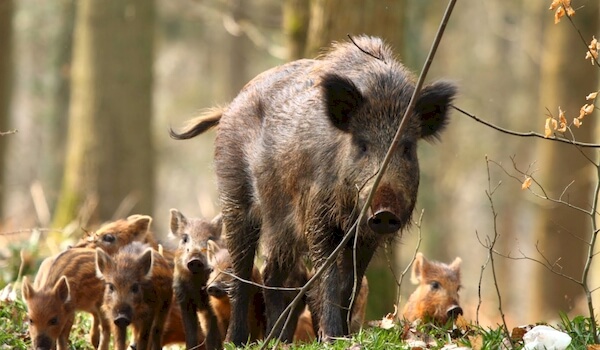
Photo : Baby Boar
As mentioned earlier, wild boars live in herds, which consist of females with boars, and mature boars return to the herd only during the mating season (rut). In different countries, it starts at different times and lasts about two months. The male discovers a herd with females, using his first-class scent and also by following the tracks left. When the mating ends, he again goes into a solitary existence. Boars are polygamous, so during the rutting period they have several female individuals.
During this mating season, the aggressiveness of males increases, so fights to the death often occur when a rival appears. Males inflict huge wounds on each other with their large fangs. The one who gives in – leaves the herd. The duration of pregnancy in females is from 120 to 130 days. The female feels the imminent arrival of childbirth and leaves the herd in advance to find a suitable cozy place for the birth of offspring. She deftly arranges her nest, using dry grass and soft branches as bedding.
Piglets are born in the amount of 5 – 15 pieces, each of them already weighs about a kilogram. The coat of babies is very soft and interesting color. It is either completely dark or light brown with white stripes along the entire back. This color masks and protects the cubs from various predatory animals.
Usually there is only one brood per year. Very rarely there are more (two or three). The female breastfeeds the young for approximately three months. Three weeks after birth, babies are already becoming stronger, more active and more independent. Mom takes care of her boars everywhere and does not let anyone near them, so during this period she is most anxious and shows aggression for any slightest reason. In case of danger, she will fight to the last breath, protecting her beloved babies, since her muscles and fangs allow.
Natural enemies of wild boars
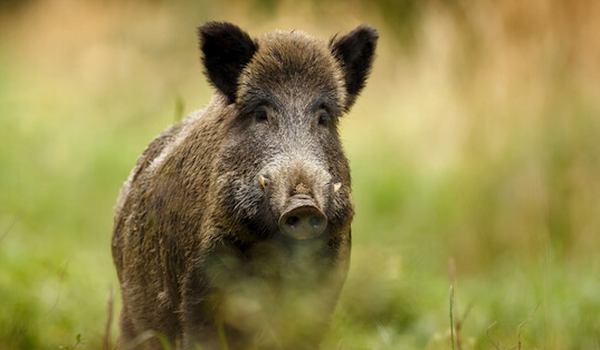
Photo: Boar
There are a lot of dangers and enemies waiting for boars. In the forest, they can be injured by a variety of prickly, sharp flooring; here, first of all, the legs of the animal suffer. Of the natural enemies, wolves, lynx and even bears are most often caught. Wolves are much smaller than a wild boar and do not have such power, so they hunt it in a whole pack. At the right moment, one of them jumps right on the boar’s back, tries to knock the boar down, then the rest of the wolves pounce on him, trying to overcome it.
The lynx also acts as a threat, only for young boars that can move away from the herd. The lynx hunts alone, so it will not cope with an adult billhook, but the lagging young are waiting. The most dangerous among the boar enemies is the bear. If in fights with other predators the wild boar has a chance to escape and survive, then there is no choice. Huge bear paws squeeze the boar so that its bones crack, and it dies from its injuries.
Despite the many dangers, the boars do not succumb to them to the last and desperately fight for their lives. A wounded billhook is very furious and angry, possesses tremendous power and strength, so he can easily deal with his ill-wishers and stay alive.
Population and species status
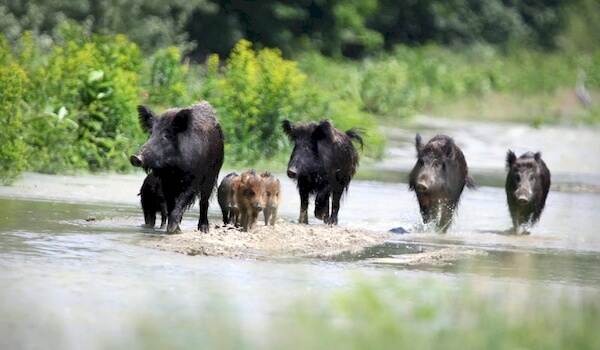
Photo : Boar animal
Nothing threatens the wild boar population in our country, and since the beginning of the 2000s, their numbers have increased significantly compared to the crisis of the nineties of the twentieth century. During the hunting season, there is a constant legal production of billhooks. In some areas, there is even an overpopulation of certain territories by animals, which causes damage to both forests and agricultural land.
When there are too many wild boars in one habitat, there is not enough food for them. In search of her, they begin to dig the ground again and again in the same places, which can damage the root system of trees, which leads to their death. With too large an increase in the population of boars, they destroy entire fields with crops, which adversely affects the yield of a particular crop. In such a situation, shooting above the norm is allowed, and the hunters get to work.
Wild boar hunting is a very risky and unpredictable business, so not every hunter can do it. It is worth remembering that a wounded boar is the most dangerous, furious beast, sweeping away everything and everyone in its path. Hunters need to be extremely careful and concentrated.
In many other countries with wild boar populations, things are not going as well as in Russia. Often, they are simply ruthlessly exterminated (Egypt, Great Britain). But, nevertheless, it is worth recalling once again that this species of animals is widely settled throughout our planet and is not endangered, because. very quickly and easily takes root in new territories.
Summing up, I would like to note that the wild boar brings considerable benefits to the places where it lives, unless, of course, its numbers are increased. It eats a variety of plant-damaging insects that harm the forested area. When a wild boar digs the ground with its fangs, this also has a beneficial effect on the soil, which leads to the abundant growth of shoots and grass. With his fangs, like a cultivator, he deftly loosens it, thus acting as a kind of forest orderly.

